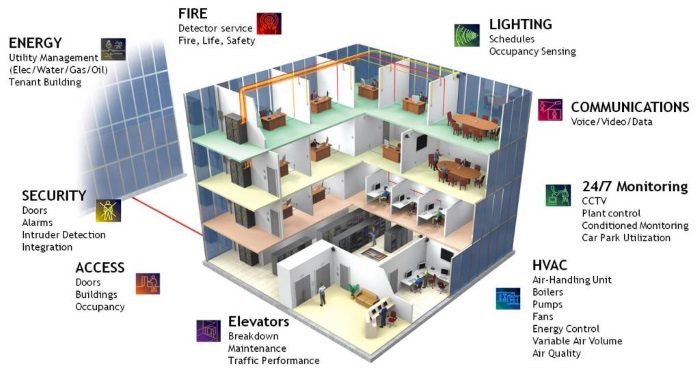By PAUL O'SHEA
Sr. Technical Editor
Electronic Products Magazine

Creating an intelligent building starts with sensors and LED lighting.
Each year for the last several years, the lighting industry got smarter as the customer and the design engineer put their creative minds together to see what is possible. The introduction of the LED light started the lighting revolution, but the LEDs were too expensive, even if they lasted much longer than incandescent or even fluorescent bulbs.
Persuading customers to switch to LEDs just because they lasted longer was a hard sell, and only the large manufacturers (such as Cree, OSRAM, Philips) could play in an uncertain market. Then the power companies joined in by offering solutions that made lighting meet some of our expectations such as offering dimming capability and efficiency of the driver/ballasts.
But customers still wanted more, like easier implementation by offering retrofits for all types of bulbs and sockets. Nope, still not enough. We the customers wanted something that had a wow factor and differentiated it from the plain-old light bulb. Meanwhile, companies like Cree kept making LEDs that had better specs than those of the previous generation and eventually were outperforming every other type of lighting, including the halogen lamps used to brighten sports stadiums and parking lots.
Designers added color and temperature control to the bulbs via the digital command functions, and that was good for digital signage. But that’s a pretty specific customer and only one market to hang your hat on. Then manufacturers like Texas Instruments and OSRAM developed integrated and sophisticated designs that could be used for the automotive industry and we started to see the cool factor in high-end cars. TI offered adaptive headlights that followed the road, making it safer and easier to drive at night, and OSRAM offered LED arrays that enabled car manufacturers to provide distinctive designer lighting. That was close to the right solution, but we still needed lighting to do something for our everyday life. We saw that when companies like ams integrated lighting control functions with something totally different – sensors. That got us to the next step in which lighting now did something that it hadn’t been done before – it added smarts to the lighting manager so that it automagically dimmed or brightened luminaires in response to sunlight or turned on/off according to occupancy.
That opened the floodgates, and many companies recognized that sensors of all types could be added to existing lighting structures and that we could connect them through the wired internet, or the smart lights could communicate wirelessly. We are already seeing smart systems that use existing power and light technologies to create sophisticated solutions in commercial and industrial buildings. The next iteration will integrate more than just power and lighting, we will see smart space planning of offices and warehouses.
Sensors in lighting – welcome to the world of IoT in your work space. Companies like Enlighted, Digital Lumens, PointGrab , and Stack Lighting recognized that the real prize is to gather data, big data, and extract the useful information to make intelligent decisions about what you need to work efficiently. That could mean keeping track of inventory so you’re not wasting time looking for it, or designing offices so that supplies and desks are in the best place for efficient use of time, or even scheduling elevators so that highly trafficked areas move people quickly and smoothly.

One concept from Digital Lumens shows the basics for an intelligent building.
Enlighted’s CEO, Joe Costello, shared a vignette during Lightfair 2016 that shows how and why businesses are putting intelligence into buildings, such as hospitals, so they can be more efficient. As you can imagine, many nurses are employed in hospitals and their time is expensive. When hospital administrators were asked what the most important process is that they wanted to control, one of the administrators said “finding available wheelchairs.” That may sound ridiculous, but consider that research tells us that nurses spend about 1 hour a day – just looking for wheelchairs and other equipment. Also, every patient needs to be escorted out of the hospital on a wheelchair, and if they can’t find one, the patient has to stay for another day, which increases the hospital bill. By adding sensors to the wheelchair, the hospital eliminates the lost time and cost of nurses looking for equipment. Patients and insurance companies save money, too, when release dates from the hospital occur on schedule.
These smart building decisions are based on many types of sensors such as passive IR and thermal. We also need to have these sensors work with processors and software algorithms, to retrieve the large amounts of data from the cloud and finally make intelligent and automated decisions. Of course that means we also need to share the information and that requires networks and communication standards to share the massive amounts of data. Fortunately, that’s already happening with the use of DALI, IEEE 802.15.4, ZigBee, Bluetooth, and other comm standards. These decisions can also be improved to meet our needs with built-in ability of the sensors to learn. The built-in smarts are getting to know us – all about us. Are we ready to give up some privacy to get it?
Advertisement





